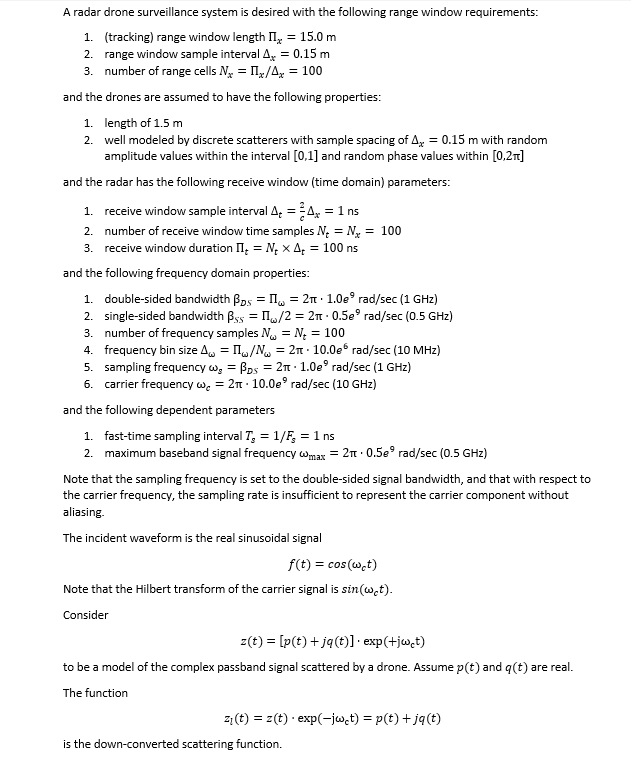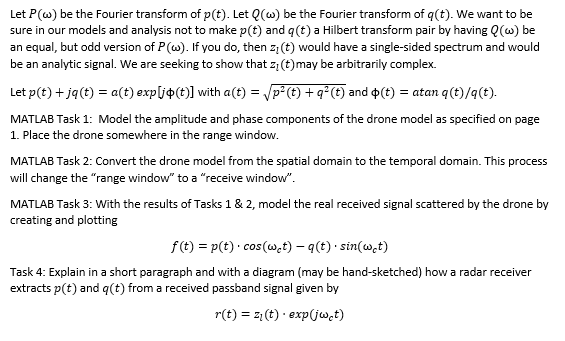Help with radar signal processing problems using MATLAB.


A radar drone surveillance system is desired with the following range window requirements: 1. (tracking) range window length 11, = 15.0 m 2. range window sample interval 4, = 0.15 m 3. number of range cells N = [1,/4 = 100 and the drones are assumed to have the following properties: 1. length of 1.5 m 2. well modeled by discrete scatterers with sample spacing of 42 = 0.15 m with random amplitude values within the interval [0,1] and random phase values within (0,21] and the radar has the following receive window (time domain) parameters: 1. receive window sample interval 4. = 24 = 1 ns 2. number of receive window time samples No = N; = 100 3. receive window duration No = N * 4 = 100 ns and the following frequency domain properties: 1. double-sided bandwidth Bos = 11. = 21. 1.0 rad/sec (1 GHz) 2. single-sided bandwidth Bss = 11./2 = 211.0.5e rad/sec (0.5 GHz) 3. number of frequency samples N. = N; = 100 4. frequency bin size 4. = 11./N. = 21. 10.0e rad/sec (10 MHz) 5. sampling frequency w, = Bps = 21. 1.0erad/sec (1 GHz) 6. carrier frequency we = 21. 10.0erad/sec (10 GHz) and the following dependent parameters 1. fast-time sampling interval T, = 1/F, = 1 ns 2. maximum baseband signal frequency Wmax = 21.0.5e rad/sec (0.5 GHz) Note that the sampling frequency is set to the double-sided signal bandwidth, and that with respect to the carrier frequency, the sampling rate is insufficient to represent the carrier component without aliasing The incident waveform is the real sinusoidal signal f(t) = cos(wet) Note that the Hilbert transform of the carrier signal is sin(wet). Consider z(t) = [p(t) + jat)]. exp(+jwet) to be a model of the complex passband signal scattered by a drone. Assume p(t) and q(t) are real. The function z(t) = z(t) . exp(-jwet) = P(t) +jat) is the down-converted scattering function. Let P(w) be the Fourier transform of p(t). Let (w) be the Fourier transform of q(t). We want to be sure in our models and analysis not to make p(t) and (t) a Hilbert transform pair by having Q(w) be an equal, but odd version of PW). If you do, then z(t) would have a single-sided spectrum and would be an analytic signal. We are seeking to show that z:(t)may be arbitrarily complex. Let p(t) +ja(t) = a(t)explj(t)] with a(t) = /p?(t) + q*(t) and (t) = atan q(t)/qt). MATLAB Task 1: Model the amplitude and phase components of the drone model as specified on page 1. Place the drone somewhere in the range window. MATLAB Task 2: Convert the drone model from the spatial domain to the temporal domain. This process will change the "range window" to a "receive window". MATLAB Task 3: With the results of Tasks 1 & 2, model the real received signal scattered by the drone by creating and plotting f(t) = p(t) cos(w.t) - 9(t) sin(wit) Task 4: Explain in a short paragraph and with a diagram (may be hand-sketched) how a radar receiver extracts p(t) and qt) from a received passband signal given by r(t) = 2(t) . expliwet) A radar drone surveillance system is desired with the following range window requirements: 1. (tracking) range window length 11, = 15.0 m 2. range window sample interval 4, = 0.15 m 3. number of range cells N = [1,/4 = 100 and the drones are assumed to have the following properties: 1. length of 1.5 m 2. well modeled by discrete scatterers with sample spacing of 42 = 0.15 m with random amplitude values within the interval [0,1] and random phase values within (0,21] and the radar has the following receive window (time domain) parameters: 1. receive window sample interval 4. = 24 = 1 ns 2. number of receive window time samples No = N; = 100 3. receive window duration No = N * 4 = 100 ns and the following frequency domain properties: 1. double-sided bandwidth Bos = 11. = 21. 1.0 rad/sec (1 GHz) 2. single-sided bandwidth Bss = 11./2 = 211.0.5e rad/sec (0.5 GHz) 3. number of frequency samples N. = N; = 100 4. frequency bin size 4. = 11./N. = 21. 10.0e rad/sec (10 MHz) 5. sampling frequency w, = Bps = 21. 1.0erad/sec (1 GHz) 6. carrier frequency we = 21. 10.0erad/sec (10 GHz) and the following dependent parameters 1. fast-time sampling interval T, = 1/F, = 1 ns 2. maximum baseband signal frequency Wmax = 21.0.5e rad/sec (0.5 GHz) Note that the sampling frequency is set to the double-sided signal bandwidth, and that with respect to the carrier frequency, the sampling rate is insufficient to represent the carrier component without aliasing The incident waveform is the real sinusoidal signal f(t) = cos(wet) Note that the Hilbert transform of the carrier signal is sin(wet). Consider z(t) = [p(t) + jat)]. exp(+jwet) to be a model of the complex passband signal scattered by a drone. Assume p(t) and q(t) are real. The function z(t) = z(t) . exp(-jwet) = P(t) +jat) is the down-converted scattering function. Let P(w) be the Fourier transform of p(t). Let (w) be the Fourier transform of q(t). We want to be sure in our models and analysis not to make p(t) and (t) a Hilbert transform pair by having Q(w) be an equal, but odd version of PW). If you do, then z(t) would have a single-sided spectrum and would be an analytic signal. We are seeking to show that z:(t)may be arbitrarily complex. Let p(t) +ja(t) = a(t)explj(t)] with a(t) = /p?(t) + q*(t) and (t) = atan q(t)/qt). MATLAB Task 1: Model the amplitude and phase components of the drone model as specified on page 1. Place the drone somewhere in the range window. MATLAB Task 2: Convert the drone model from the spatial domain to the temporal domain. This process will change the "range window" to a "receive window". MATLAB Task 3: With the results of Tasks 1 & 2, model the real received signal scattered by the drone by creating and plotting f(t) = p(t) cos(w.t) - 9(t) sin(wit) Task 4: Explain in a short paragraph and with a diagram (may be hand-sketched) how a radar receiver extracts p(t) and qt) from a received passband signal given by r(t) = 2(t) . expliwet)








